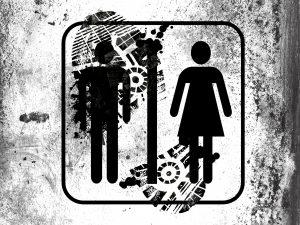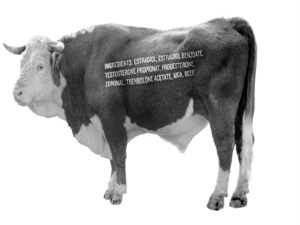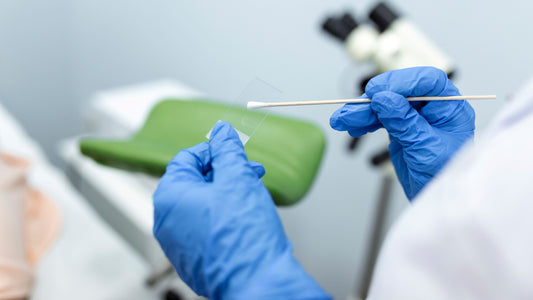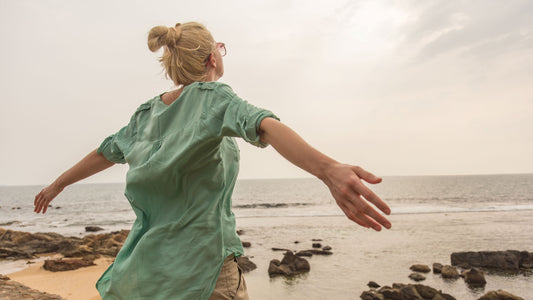I travel a good deal and am often confronted with that feeling of dread that most
women display when needing to use a public toilet. Ewww!

You enter the restroom, scanning the environment to assess just how dirty it might be. Then you typically pick the stall at the far end thinking it will be more private or less utilized (research confirms this!), push open the door with a grimace on yourface, hoping for the best.
Often-times you’ll find an unflushed toilet, used seat covers still half on the seat (sometimes even wet!), pee on the seat and other unsanitary looking remnants from the previous occupants.
You likely then do one of three things. You either decide to “hover” over the seat and not touch anything. Or you do some toilet seat cleaning and then cover the seat with a toilet cover or tissues.
And hopefully you don’t decide to just hold it! (which some of you likely routinely do!) Holding it when you need to go puts a lot of strain on your pelvic muscles which can cause you problems down the road, so let’s remove that as a third option, please!
So which one do YOU do most often…hover or cover? And what is the real risk from that public restroom experience?
But first…is the toilet even the dirtiest spot in that restroom?
Before we set our “yuck” focus entirely on the toilet, let’s consider that the toilet seat isn’t necessarily a worse bacteria petri-dish than the restroom floor is. Do you put your purse, backpack or child down on the restroom floor? And I hate to tell you that if the toilet seat scares you, do some research on the bacteria found on a typical kitchen sponge!
A lot of research has been done on this question of, “what is the dirtiest spot in a typical public restroom”, and the toilet is not the worst offender in terms of where all the “bad” bacteria can be found. Restroom floors, sinks and sanitary napkin disposal bins are also highly contaminated with both urine and fecal matter.
Coliform bacteria (feces related…can I hear another “yuck”!) were found more than 50% of the time at three sites: sanitary napkin disposal bin, the floor in front of the toilet, and the drain of the sink basin.
E.coli was most commonly found at the sanitary napkin disposal bin in the same study.
So maybe your dread and concern about toilet seat hygiene is more mental than physical! LOL.
But having said that, it is still true that the toilet seat – and stall – has a variety of bacteria present. So let’s talk about the risk for your contracting some type of infection from sitting on or being near that toilet seat.
Can you Get an Infection from a Toilet Seat?

It used to be that people viewed urine as completely sterile…is that what you thought?
So the avoidance of sitting on toilets in public restrooms has been more related to the “yuck” factor for most people versus their being concerned about contracting infections.
But more and more we’re learning that urine contains all types of bacteria related to an individual’s microbiome. For example, we know that certain sexually transmitted diseases, such as trichomonas and chlamydia, can colonize in the urinary tract. So that pee you find on your stall’s toilet seat…could it contain some of that live bacteria?
The general consensus on this from the medical community and research is that your risk of getting an infection from sitting on a toilet seat is really small. So catching infections such as herpes simplex virus and human papillomavirus, for example; or sexually transmitted diseases (STDs) like gonorrhea, trichomonas and chlamydia would be incredibly unlikely. Most of these bacteria die off quickly in the environment and you would have to have immediate exposure to the bacteria, as well as a cut, abrasion or break in your skin on your butt exactly where the bacteria was on the seat.
Peed-upon seats are not as risky as those having some type of fecal matter on them. And unfortunately, fecal matter can be invisible to the eye. In fact, research has shown that the bacteria in fecal matter can be literally propelled into the air when a toilet is flushed! Once the toilet is flushed, and most of the water has left the bowl, there is an airborne mist containing microscopic poop particles that can be released into the air.
Double yuck!
So how does one fend these exposures off?
Luckily a Healthy Body has Some Natural Protection!
Your body is naturally protected by two systems in this case!
Having a strong immune system is one protective system, and your skin – as a barrier to bacteria penetrating inside your body – is the other. Regarding the skin, though, note that if the exposure is directly to the vulva, vagina or rectum itself the risk of infection is greater than just touching the skin of your buttocks. The membranes of these areas are very absorbent.
So you could – given the right conditions – be exposed to bacteria from someone’s urinary tract left in their pee on a toilet seat, and have that absorb into your vulva (if your vulva came into contact with the pee). Once absorbed the bacteria would likely start to colonize due to the warm, moist climate in your “down under”. Again, a very small risk.
But as a doctor I think we should take the view that this risk may be growing over time as we see more and more antibiotic-resistant bacteria. Now if you were to catch an infection it may be more difficult to treat. There are many studies that show antimicrobial resistance can be significant. And studies that show different types of people are at greater risks for different types of bacteria resistance.
For example, one study found that the most common bad bacteria found in urine samples of menopausal women was E.coli (Escherichia coli), which was found in 65.5% of the samples taken. And shockingly, when this bacterial infection was treated with the popularly prescribed antibiotic, ampicillin, over 40% of the bacteria were resistant to the antibiotic. And resistance of all the bacteria found in the urine samples was higher in postmenopausal women!
So what does this mean? Even though the risk of infection is low, the impact of the risk could be great if the antibiotic used for treatment doesn’t work well on the particular bacteria. This is another great reason we should all minimize our antibiotic intake and eat food that doesn’t have antibiotics in it.
So What Can You Do to Minimize your Risk
Research has shown that your initial impression of how clean or dirty a public restroom is does have an impact on the amount of bacteria likely to be found there. In studies, when people have thought the bathroom looked dirty, more bacteria were found. So, if your impression is that a public bathroom is filthy take more caution!
Also, the first stall as you walk in the restroom is typically the least used.
And hate to tell you but women’s restrooms contain MORE bacteria than men’s restrooms! Likely due to the fact that we often have small children in tow or using the bathroom stall next to us (and please, don’t leave your kids’ mess in the bathroom! I was always very diligent in cleaning up after my little ones…as a doctor and woman who dreads coming across such messes, I just couldn’t leave things in a “yuck” state.)
The Question of Cover or Hover!

If I am in a public restroom and need to do a Number 1, I typically hover.
Check out my travel video on hovering
A good hover requires strong pelvic muscles, another reason to do your Kegels regularly.
If I need to do a Number 2, I take the time to clean the toilet seat and cover it. I also don’t flush (unless it is automatic) until I am ready to leave the stall so that I am out of there should any microscopic poop particles be flying through the air.
If a toilet is particularly gross I may opt to take a seat cover and use that to flush the toilet…or if REALLY gross I have been known to flush with my shoe.
I then always wash my hands (like doctors are trained to do!). And may use a towel or my own scarf to open the door of the restroom (again, depending on my perception of “clean”).
And by the way, I try not to rush it as well. Many women tend to rush as we’ve trained ourselves that we need to (because the kids are waiting, or whatever). Rushing and forcing urine or poop creates pressure, and pressure is not good for our pelvic floor health.
And frankly, the most important thing I do is to keep my microbiome strong so that my body can fight off any invaders.
Keep your Microbiome Strong
We all have a population of good and bad bacteria in our gut…referred to as the gut microbiome. Antibiotics, stress, poor diets, environmental toxins…and so much more can affect the balance of your microbiome, and researchers are showing that the microbiome can affect our immunity, our overall health, and even our brain health.
In order to have the greatest immune health our microbiome needs to be strong, which means the good guys need to be in control of the bad guys and there needs to be a very diverse population of bacteria overall. We have some 100 trillion bacteria and the more diverse our individual microbiome is the stronger our immune system. The vast majority of bacteria – some 97% – are beneficial or benign. All the afore-mentioned things like overuse of antibiotics can kill off populations of different bacteria, reducing your microbiome diversity and making you more susceptible to infections and disease.
So I do not use antibacterial soaps for this reason. While good hygiene, such as hand-washing, is important…let’s not all dip ourselves in antibiotics and other chemicals with the goal of being as sterile as possible. This results in more bacteria becoming resistant to such antibiotics, and also makes our own microbiomes behave differently (and not as effectively in terms of our immune health). I like to use healthy cleaners around the house, including my DIY toilet cleaner, and citrus-based cleaning products which help protect my family from infection but don’t kill off other bacteria!

Don’t eat antibiotics in your food, either! Eating meat with antibiotics in it is also something you should consider not doing! I purchase organic foods so that my family does not get antibiotics, hormones and other toxic chemicals that directly impact our immune system and overall health.
Eat healthy foods that support a strong immune system, get your vitamin D, get enough quality sleep…all will help your body’s immune system to fend off germs of all kinds.
Don’t Obsess!
The final note on this topic is that it isn’t something to obsess over! Like I mentioned earlier, the sponge in your kitchen has a lot of bacteria as well. Another big one is your desk at work! So why doesn’t all of this bacteria kill us? Thankfully our immune systems protect us from a great deal, so take care of your immune system!
As a mother I have tried to follow the guideline that germs can be good! The more we expose ourselves to everyday germs the more our immune system can deal with them.
COMMENTS?
What do YOU do in public restrooms? Any tips for my community? Let us know!



